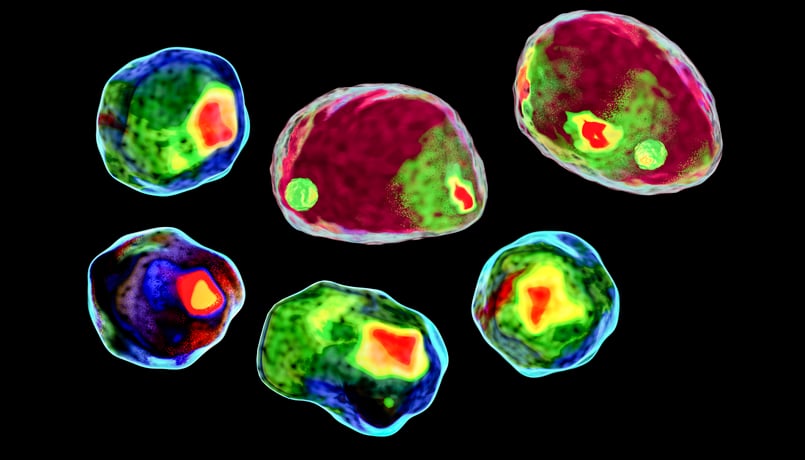

Cell Sorting by Flow Cytometry
Flow cytometry-based cell sorting can be a powerful tool in clinical research, particularly in the fields of immunology and oncology, enabling the identification, isolation, and characterization of specific cell populations. Use that data to meet your clinical endpoints for disease-specific biomarker discovery and patient stratification.
Combined with single cell sequencing analysis, cell sorting can be a useful way to study the functional heterogeneity within tumor microenvironments.
Measure a range of endpoints with FACS
Simultaneously analyze multiple proteins, gene expression, and cell functions for a range of clinical endpoints. Precision offers flow cytometry assays to span many research applications.
Define what you’re studying:
- Rare cell population studies
- Immune cell profiling
- Omics studies-protein/DNA/RNA; single-cell qPCR
- Subcellular particle analysis (microvesicles, exosomes, isolation) enriching nuclei for single-cell epigenomics
- Separate cell subsets based on surface markers for for disease-specific biomarker discovery and patient stratification
- Screen CRISPR libraries
- Gene editing programs
- TCR heterogeneity

Start with a range of accepted sample matrices:
- Fresh whole blood,
- Fresh tumor tissue
- Tumor infiltrating lymphocytes (TILs) & other cells in the tumor
- Tumor deposits
- CTCs
- Draining lymph nodes, spleen, peripheral blood
- Myeloid derived suppressor cells (MDSC) and M1/M2 Macrophages

What is FACS?
Fluorescence-activated cell sorting (FACS) is a technique used in both basic and clinical research to isolate single cells from a heterogeneous sample for further analysis or therapeutic applications, based on a fluorochrome bound to a detection antibody. At Precision, we can sort many cell populations using 16-18 different parameters from a heterogeneous cell mixture and can sort low-volume or single cells into 96- or 38 -well plates for a multitude of downstream applications.
Frequently Asked Questions
Key consideration: what is the downstream assay?
This drives the main features of the sort: purity, yield, or speed of sorting. The higher the purity requirements, then the slower the sort and lower the yield. If speed is of the essence, then the final sorted population may be enriched in the target cells, but the purity may be compromised. Consult Precision’s scientific experts to recommend a plan.
What is the regulatory level requested by for a clinical flow cytometry panel?
The degree of validation is dependent of the context of use. An exploratory end point on a clinical study will have to be evaluated in terms of sample stability, precision, and the characterization of key markers and critical reagents. While this analysis does not generally need to claim GCP or CLIA compliance, sponsors may request a flow cytometry assay validated and executed to this level of compliance at selected sites around the globe.
Uncover new insights on flow cytometry
Explore best-practice methods and find useful considerations and tips for experimental design, sample prep, and data analysis.
Values of Precision flow cytometry
-
Established experience
Established experience running complex flow cytometry in gene therapy, cell therapy, and immuno-oncology therapies, validating up to CLIA -
Senior staff
Sample testing by senior staff with >5 years of experience who understand the disease biology and gating strategy -
Quality control
Real-time quality control during the run to ensure sample integrity

Discover how our flow cytometry expertise can advance your clinical development program
Enhance your clinical results with complementary lab services
-
Explore


Epiontis ID® Epigenetic Cell Profiling
ExplorePrecision’s proprietary immune monitoring technology which delivers robust, repeatable, and cost-effective immune cell phenotyping on any sample type
Epiontis ID® Epigenetic Cell Profiling
ExplorePrecision’s proprietary immune monitoring technology which delivers robust, repeatable, and cost-effective immune cell phenotyping on any sample type -
Explore


Cytokine Profiling & Proteomics
ExploreCustomized assays to detect cytokines or proteins of interest utilizing ELISA, Luminex, MSD, and Western Blotting

Cytokine Profiling & Proteomics
ExploreCustomized assays to detect cytokines or proteins of interest utilizing ELISA, Luminex, MSD, and Western Blotting
-
Explore


Large Molecule PK
ExploreDevelopment, validation, and implementation using ELISAs and MSD assays for biologics, flow cytometry, and ddPCR for cell-based therapies
Large Molecule PK
ExploreDevelopment, validation, and implementation using ELISAs and MSD assays for biologics, flow cytometry, and ddPCR for cell-based therapies

